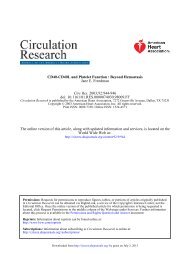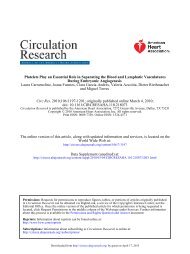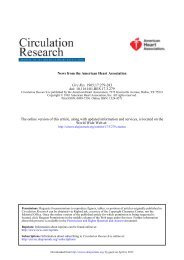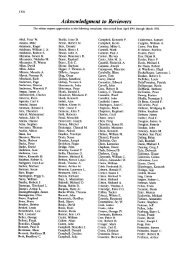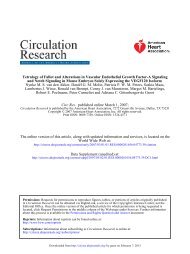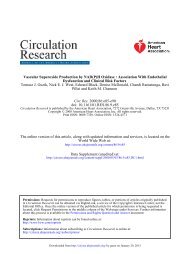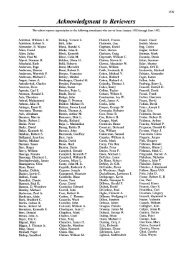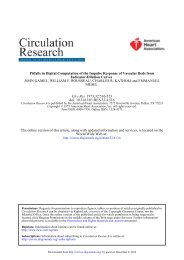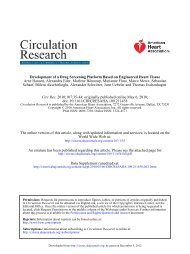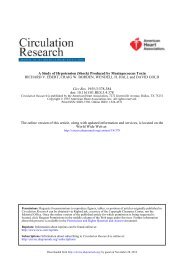Role of Sarcoplasmic Reticulum in Arterial Contraction: Comparison ...
Role of Sarcoplasmic Reticulum in Arterial Contraction: Comparison ...
Role of Sarcoplasmic Reticulum in Arterial Contraction: Comparison ...
You also want an ePaper? Increase the reach of your titles
YUMPU automatically turns print PDFs into web optimized ePapers that Google loves.
<strong>Role</strong> <strong>of</strong> sarcoplasmic reticulum <strong>in</strong> arterial contraction: comparison <strong>of</strong> ryanod<strong>in</strong>es's effect <strong>in</strong><br />
a conduit and a muscular artery.<br />
T Ashida, J Schaeffer, W F Goldman, J B Wade and M P Blauste<strong>in</strong><br />
Circ Res. 1988;62:854-863<br />
doi: 10.1161/01.RES.62.4.854<br />
Circulation Research is published by the American Heart Association, 7272 Greenville Avenue, Dallas, TX 75231<br />
Copyright © 1988 American Heart Association, Inc. All rights reserved.<br />
Pr<strong>in</strong>t ISSN: 0009-7330. Onl<strong>in</strong>e ISSN: 1524-4571<br />
The onl<strong>in</strong>e version <strong>of</strong> this article, along with updated <strong>in</strong>formation and services, is located on the<br />
World Wide Web at:<br />
http://circres.ahajournals.org/content/62/4/854<br />
Permissions: Requests for permissions to reproduce figures, tables, or portions <strong>of</strong> articles orig<strong>in</strong>ally published <strong>in</strong><br />
Circulation Research can be obta<strong>in</strong>ed via RightsL<strong>in</strong>k, a service <strong>of</strong> the Copyright Clearance Center, not the<br />
Editorial Office. Once the onl<strong>in</strong>e version <strong>of</strong> the published article for which permission is be<strong>in</strong>g requested is<br />
located, click Request Permissions <strong>in</strong> the middle column <strong>of</strong> the Web page under Services. Further <strong>in</strong>formation<br />
about this process is available <strong>in</strong> the Permissions and Rights Question and Answer document.<br />
Repr<strong>in</strong>ts: Information about repr<strong>in</strong>ts can be found onl<strong>in</strong>e at:<br />
http://www.lww.com/repr<strong>in</strong>ts<br />
Subscriptions: Information about subscrib<strong>in</strong>g to Circulation Research is onl<strong>in</strong>e at:<br />
http://circres.ahajournals.org//subscriptions/<br />
Downloaded from<br />
http://circres.ahajournals.org/ by guest on April 6, 2013
854<br />
<strong>Role</strong> <strong>of</strong> <strong>Sarcoplasmic</strong> <strong>Reticulum</strong> <strong>in</strong> <strong>Arterial</strong><br />
<strong>Contraction</strong>: <strong>Comparison</strong> <strong>of</strong> Ryanod<strong>in</strong>e's Effect<br />
<strong>in</strong> a Conduit and a Muscular Artery<br />
Terunao Ashida, Juergen Schaeffer, William F. Goldman, James B. Wade,<br />
and Mordecai P. Blauste<strong>in</strong><br />
Ryanod<strong>in</strong>e <strong>in</strong>terferes with sarcoplasmic reticulum function <strong>in</strong> various types <strong>of</strong> muscle; <strong>in</strong> vascular<br />
smooth muscle, it can <strong>in</strong>hibit contractions that depend on sarcoplasmic reticulum calcium release,<br />
probably by deplet<strong>in</strong>g the sarcoplasmic reticulum calcium store. We tested ryanod<strong>in</strong>e and calcium<br />
channel blockers (verapamil, diltiazem, and nitrendip<strong>in</strong>e) on small r<strong>in</strong>gs <strong>of</strong> rat thoracic aorta (RA)<br />
and bov<strong>in</strong>e tail artery (BTA) to determ<strong>in</strong>e the relative contributions <strong>of</strong> sarcoplasmic reticulum calcium<br />
release and gated calcium entry to contractions <strong>in</strong>duced by norep<strong>in</strong>ephr<strong>in</strong>e, caffe<strong>in</strong>e, and 100 mM K<br />
depolarization. Ryanod<strong>in</strong>e blocked caffe<strong>in</strong>e contractions <strong>in</strong> both tissues and attenuated norep<strong>in</strong>ephr<strong>in</strong>e<br />
responses (by 52% <strong>in</strong> RA, 14% <strong>in</strong> BTA) but m<strong>in</strong>imally altered potassium contractions. Calcium<br />
channel blockers almost completely abolished potassium contractions and reduced norep<strong>in</strong>ephr<strong>in</strong>e<br />
contractions (by 45% <strong>in</strong> RA, 82% <strong>in</strong> BTA) but hardly affected caffe<strong>in</strong>e responses. The block<strong>in</strong>g effects<br />
<strong>of</strong> ryanod<strong>in</strong>e and calcium channel antagonists on the norep<strong>in</strong>ephr<strong>in</strong>e responses were additive.<br />
Ryanod<strong>in</strong>e had no effect on basel<strong>in</strong>e tension <strong>in</strong> the standard media; however, when calcium extrusion<br />
via Na-Ca exchange was <strong>in</strong>hibited by low external sodium (0-calcium, low-sodium solution), tension<br />
<strong>in</strong>creased progressively after <strong>in</strong>troduction <strong>of</strong> ryanod<strong>in</strong>e. This <strong>in</strong>dicates that the sarcoplasmic reticulum<br />
calcium released by ryanod<strong>in</strong>e then accumulated <strong>in</strong> the cytosol and activated contraction; restoration<br />
<strong>of</strong> external sodium caused prompt relaxation.The smaller effects <strong>of</strong> caffe<strong>in</strong>e and ryanod<strong>in</strong>e <strong>in</strong> BTA<br />
<strong>in</strong>dicate that sarcoplasmic reticulum plays a less important role <strong>in</strong> calcium control <strong>in</strong> this tissue, with<br />
gated calcium entry dom<strong>in</strong>at<strong>in</strong>g. These functional f<strong>in</strong>d<strong>in</strong>gs are correlated with electron-microscopic<br />
evidence that BTA has about 60% less sarcoplasmic reticulum than does RA. Ryanod<strong>in</strong>e appears to<br />
be a useful tool for determ<strong>in</strong><strong>in</strong>g the functional relevance <strong>of</strong> sarcoplasmic reticulum for contraction<br />
<strong>in</strong> different arterial smooth muscles. (Circulation Research 1988;62:854-863)<br />
<strong>Contraction</strong> <strong>of</strong> mammalian arterial smooth muscle<br />
is normally triggered by an <strong>in</strong>crease <strong>in</strong> the<br />
cytosolic free calcium concentration,' [Ca 2+ ]|.<br />
This "trigger calcium" can come either from the<br />
extracellular fluid or from <strong>in</strong>tracellular stores <strong>in</strong> the<br />
sarcoplasmic reticulum (SR). Calcium can enter the<br />
cells through voltage-gated channels or receptoroperated<br />
channels that admit calcium 1 ; dur<strong>in</strong>g depolarization,<br />
calcium entry may also be mediated by<br />
voltage-sensitive Na-Ca exchange. 2 Alternatively, or <strong>in</strong><br />
addition, calcium may be released from SR by a<br />
calcium-<strong>in</strong>duced calcium release mechanism, 3 and/or<br />
by an <strong>in</strong>ositol trisphosphate-activated mechanism. 4 - 5<br />
The relative roles <strong>of</strong> the calcium entry mechanisms and<br />
SR calcium release are likely to vary with different types<br />
From the Department <strong>of</strong> Physiology, University <strong>of</strong> Maryland<br />
School <strong>of</strong> Medic<strong>in</strong>e, Baltimore, Maryland.<br />
Supported by National Institutes <strong>of</strong> Health grant AM-32276 and<br />
a grant from the Muscular Dystrophy Association to M.P.B.; by an<br />
NSF shared <strong>in</strong>strument grant DMB-8500564 to J.B.W.; by a Veteran<br />
Adm<strong>in</strong>istrations research grant to Dr. Bruce P. Hamilton; and by<br />
postdoctoral fellowships from the Eli Lilly Company to T.A., from<br />
the American Heart Association, Maryland Affiliate to W.F.G., and<br />
from the Deutsche Forschungsgeme<strong>in</strong>schaft to J.S.<br />
Address for correspondence: Mordecai P. Blauste<strong>in</strong>, MD, Department<br />
<strong>of</strong> Physiology, University <strong>of</strong> Maryland School <strong>of</strong> Medic<strong>in</strong>e,<br />
655 West Baltimore Street, Baltimore, MD 21201.<br />
Dr. Ashida's present address: Department <strong>of</strong> Internal Medic<strong>in</strong>e,<br />
National Cardiovascular Center, Suita City/Osaka, Japan.<br />
Received Jury 13, 1987; accepted November 5, 1987.<br />
<strong>of</strong> vasoconstrictors (e.g., potassium depolarization promotes<br />
calcium entry, 6 - 7 while caffe<strong>in</strong>e promotes SR<br />
calcium release 8 ) and <strong>in</strong> different arterial tissues. The<br />
actual amount <strong>of</strong> SR is likely to be a key determ<strong>in</strong>ant <strong>in</strong><br />
the mode <strong>of</strong> activation <strong>of</strong> the <strong>in</strong>dividual arteries. For<br />
example, large conduit arteries appear to have a more<br />
extensive SR than do smaller muscular arteries. 9 Thus, the<br />
SR may play only a limited role <strong>in</strong> excitation-contraction<br />
coupl<strong>in</strong>g <strong>in</strong> small muscular arteries; conversely, the<br />
movement <strong>of</strong> calcium across the sarcolemma is likely to<br />
play a larger role <strong>in</strong> these vessels.<br />
The contribution <strong>of</strong> gated calcium entry to contraction<br />
can conveniently be studied by application <strong>of</strong><br />
selective organic calcium channel blockers. Functional<br />
assessment <strong>of</strong> the role <strong>of</strong> the SR <strong>in</strong> contraction is more<br />
difficult, however, and has <strong>in</strong>volved measurements <strong>of</strong><br />
contractions <strong>in</strong> calcium-free media 10 " 12 or <strong>in</strong> the presence<br />
<strong>of</strong> caffe<strong>in</strong>e (to deplete the SR calcium stores). 8<br />
Unfortunately, studies employ<strong>in</strong>g caffe<strong>in</strong>e are complicated<br />
by the fact that it has at least two major<br />
antagonistic actions: caffe<strong>in</strong>e promotes contraction by<br />
releas<strong>in</strong>g calcium from the SR 8 and <strong>in</strong>hibits cyclic<br />
nucleotide phosphodiesterase, 13 elicit<strong>in</strong>g a rise <strong>in</strong><br />
cyclic nucleotide levels that may be expected to<br />
promote smooth muscle relaxation."<br />
Ryanod<strong>in</strong>e is another naturally occurr<strong>in</strong>g alkaloid<br />
that <strong>in</strong>terferes with SR function. 1516 It <strong>in</strong>hibits evoked<br />
SR calcium release, <strong>in</strong> part by promot<strong>in</strong>g a slow<br />
depletion <strong>of</strong> the calcium store. 1720 Several <strong>in</strong>vestigators<br />
Downloaded from<br />
http://circres.ahajournals.org/ by guest on April 6, 2013
have shown that ryanod<strong>in</strong>e is effective on vascular<br />
smooth muscle. 3>2O ~ 22 In contrast to caffe<strong>in</strong>e, which<br />
causes a rapid release <strong>of</strong> calcium from SR with a<br />
transient contraction, ryanod<strong>in</strong>e usually does not itself<br />
<strong>in</strong>duce a rise <strong>in</strong> tension. Furthermore, ryanod<strong>in</strong>e does<br />
not appear to affect the contractile apparatus or the<br />
sarcolemmal calcium transport mechanisms. 18 Therefore,<br />
this alkaloid may be especially useful for assess<strong>in</strong>g<br />
the relative role <strong>of</strong> the SR <strong>in</strong> vascular smooth muscle<br />
contraction. We compared the effects <strong>of</strong> ryanod<strong>in</strong>e on<br />
a conduit artery (rat thoracic aorta) and a small<br />
muscular artery (bov<strong>in</strong>e tail artery). This artery is<br />
comparable <strong>in</strong> size to the rat aorta (about 1.5 mm<br />
diameter) and is particularly <strong>in</strong>terest<strong>in</strong>g because small<br />
resistance vessels (200-300 (xm diameter), whose cells<br />
are virtually identical <strong>in</strong> morphology to those <strong>of</strong> the<br />
ma<strong>in</strong> tail artery (see "Results"), branch directly from<br />
the tail artery. These functional studies are correlated<br />
with morphological evidence that the rat aorta conta<strong>in</strong>s<br />
a much more extensive SR than does the bov<strong>in</strong>e tail<br />
artery. Prelim<strong>in</strong>ary reports <strong>of</strong> some <strong>of</strong> these f<strong>in</strong>d<strong>in</strong>gs<br />
have been published <strong>in</strong> abstract form. 23 - 24<br />
Materials and Methods<br />
Tissues<br />
Small r<strong>in</strong>gs <strong>of</strong> artery (approximately 1.5 mm diameter<br />
and 2-3 mm long) were obta<strong>in</strong>ed from bov<strong>in</strong>e tail<br />
artery (distal end) and rat thoracic aorta. Normal<br />
Sprague-Dawley rats (200-300 g) were killed by<br />
decapitation. The thoracic aorta was rapidly excised<br />
and placed <strong>in</strong>to Krebs solution at 37° C. Tails from<br />
normal steers were obta<strong>in</strong>ed at a local slaughterhouse.<br />
The distal end <strong>of</strong> the bov<strong>in</strong>e tail artery was excised<br />
with<strong>in</strong> 1-1 Vi hours <strong>of</strong> slaughter and placed <strong>in</strong>to Krebs<br />
solution. In all tension experiments, the arteries were<br />
cleaned <strong>of</strong> surround<strong>in</strong>g connective tissue and equilibrated<br />
<strong>in</strong> the warm Krebs solution until rest<strong>in</strong>g tension<br />
was stabilized at 500 mg (for at least 1 hour) before data<br />
collection was <strong>in</strong>itiated.<br />
Solutions<br />
The tissues were <strong>in</strong>cubated <strong>in</strong> a modified Krebs<br />
solution conta<strong>in</strong><strong>in</strong>g (mM) NaCl 138, KC1 4.7,<br />
NaH2PO4 1.2, CaCl2 1.8, MgSO4 1.2, glucose 10,<br />
HEPES 10, adjusted to pH 7.4 with Tris and gased with<br />
100% O2. In some experiments, the potassium concentration<br />
was <strong>in</strong>creased by replac<strong>in</strong>g some <strong>of</strong> the<br />
sodium chloride with equimolar potassium chloride. In<br />
0-calcium solutions, calcium was replaced with equimolar<br />
MgCl2. In low-sodium solutions (sodium 1.2<br />
mM) Af-methyl-glucam<strong>in</strong>e (138 mM) was used as the<br />
substitut<strong>in</strong>g cation and pH was adjusted to 7.4 with<br />
hydrogen chloride.<br />
Special Reagents and Drugs<br />
The follow<strong>in</strong>g drugs were used: ryanod<strong>in</strong>e (Penick<br />
Corp, Lyndhurst, New Jersey), dantrolene-Na and<br />
diltiazem (Tanabe Co, Japan), nitrendip<strong>in</strong>e (Miles<br />
Pharmaceuticals, Westhaven, Connecticut), verapamil-HCl<br />
(Knoll Pharmaceuticals, Whippany, New<br />
Jersey), /-norep<strong>in</strong>ephr<strong>in</strong>e-HCl and caffe<strong>in</strong>e (Sigma<br />
Ashida et al Ryanod<strong>in</strong>e, <strong>Sarcoplasmic</strong> <strong>Reticulum</strong>, and <strong>Arterial</strong> <strong>Contraction</strong> 855<br />
Chemical, St. Louis, Missouri), and prazos<strong>in</strong>-HCl<br />
(Pfizer Laboratories, New York). Dantrolene and<br />
nitrendip<strong>in</strong>e were kept as 10-mM stock solutions <strong>in</strong><br />
poryethylenegh/col (#400) <strong>in</strong> opaque conta<strong>in</strong>ers.<br />
These agents were added to the Krebs solution as<br />
<strong>in</strong>dicated <strong>in</strong> "Results."<br />
<strong>Contraction</strong> Measurements<br />
Two th<strong>in</strong> (0.4 mm diameter) sta<strong>in</strong>less steel hooks<br />
were <strong>in</strong>serted through the lumen <strong>of</strong> the artery r<strong>in</strong>g. One<br />
hook was fixed to the floor <strong>of</strong> a small jacketed tissue<br />
chamber (volume 0.75 ml); the other hook was<br />
connected to a Harvard Model #52-9529 or Model<br />
#363 force transducer (South Natick, Massachusetts)<br />
that was mounted immediately above the tissue chamber.<br />
Isometric tension was cont<strong>in</strong>uously monitored and<br />
recorded on a strip chart recorder. The tissue was<br />
steadily supervised at a rate <strong>of</strong> 2 ml/m<strong>in</strong> with welloxygenated<br />
<strong>in</strong>cubation fluid at 37° C. Most drugs and<br />
other reagents were added directly to the superfusion<br />
fluids and allowed to reach a steady concentration <strong>in</strong> the<br />
<strong>in</strong>cubation fluid with<strong>in</strong> the tissue chamber. Usually,<br />
however, norep<strong>in</strong>ephr<strong>in</strong>e (NE) was applied as a small<br />
(25 |il) bolus <strong>in</strong>jection <strong>in</strong>to the superfusion l<strong>in</strong>e; the NE<br />
was thus diluted 30-fold when it reached the tissue<br />
chamber. Under these circumstances, the concentration<br />
<strong>of</strong> NE <strong>in</strong> the <strong>in</strong>cubation chamber rose rapidly to a peak<br />
that lasted 15-25 seconds; the NE concentration then<br />
decl<strong>in</strong>ed with a half-time <strong>of</strong> 15 seconds. Very reproducible<br />
NE-activated contractions were normally obta<strong>in</strong>ed<br />
under these conditions (see "Results").<br />
Electron Microscopy<br />
Fresh segments <strong>of</strong> rat aorta and bov<strong>in</strong>e tail artery (three<br />
animals each) were fixed <strong>in</strong> 2.5% glutaraldehyde and<br />
postfixed for 30 m<strong>in</strong>utes with 1% OsO4 <strong>in</strong> cacodylate<br />
buffer. Subsequently, the tissue was dehydrated and<br />
embedded <strong>in</strong> Epon. Th<strong>in</strong> sections (60-90 nm) were<br />
poststa<strong>in</strong>ed with uranyl acetate and lead citrate and<br />
exam<strong>in</strong>ed <strong>in</strong> a Zeiss 10 CA electron microscope.<br />
Morphometry<br />
Grids were coded, and random micrographs were<br />
obta<strong>in</strong>ed without knowledge <strong>of</strong> the tissue <strong>of</strong> orig<strong>in</strong>. If,<br />
at the magnification necessary to visualize SR, the<br />
entire cell cross-section could not be <strong>in</strong>cluded, a<br />
random region <strong>of</strong> the cell that <strong>in</strong>cluded the cell surface<br />
and part <strong>of</strong> the nucleus was chosen. Electron micrographs<br />
<strong>of</strong> four to six arterial smooth muscle cells from<br />
each animal (three rats and three steers) were taken on<br />
a random basis and enlarged to a f<strong>in</strong>al magnification <strong>of</strong><br />
25,000 x. The micrographs were evaluated morphometricalry<br />
us<strong>in</strong>g the po<strong>in</strong>t grid planimetry method. 25 A<br />
1-cm po<strong>in</strong>t grid was used for quantification <strong>of</strong> nucleusfree<br />
cell volume. The area <strong>of</strong> SR (membrane-bound<br />
cytoplasmiccisternae, tubules, and vesicles) and rough<br />
endoplasmic reticulum (RER; ribosome-covered membranes)<br />
was quantitated with a 0.5-cm po<strong>in</strong>t grid. These<br />
data were expressed as volume percent <strong>of</strong> nucleus-free<br />
cell volume, giv<strong>in</strong>g a proportional estimate <strong>of</strong> SR and<br />
RER content <strong>in</strong> the cytoplasm.<br />
Downloaded from<br />
http://circres.ahajournals.org/ by guest on April 6, 2013
856 Circulation Research Vol 62, No 4, April 1988<br />
-A<br />
Cat. K<br />
H nU 100 mil<br />
.200 mg<br />
Ryanodhw 10 u<br />
._• V<br />
Cat. K<br />
5 mU 100 mM<br />
FIGURE 1. Effect <strong>of</strong> ryanod<strong>in</strong>e (10 \LM) on contractions<br />
<strong>in</strong>duced by 100 mM K and 5 mM caffe<strong>in</strong>e <strong>in</strong> rat aortic r<strong>in</strong>g.<br />
Tissue was <strong>in</strong>cubated <strong>in</strong> ryanod<strong>in</strong>e for 45 m<strong>in</strong>utes before data<br />
for right-hand side were collected. Each contraction was<br />
preceded by a rest<strong>in</strong>g phase <strong>of</strong> at least 20-30 m<strong>in</strong>utes. Rest<strong>in</strong>g<br />
tension, 500 mg.<br />
Results<br />
Ryanod<strong>in</strong>e Selectively Blocks Calcium Release From<br />
<strong>Arterial</strong> Muscle <strong>Sarcoplasmic</strong> <strong>Reticulum</strong><br />
As illustrated <strong>in</strong> Figure 1, ryanod<strong>in</strong>e completely<br />
blocked caffe<strong>in</strong>e-<strong>in</strong>duced contractions <strong>in</strong> rat aorta but<br />
had only a m<strong>in</strong>imal effect on potassium-<strong>in</strong>duced<br />
contractions. This is consistent with evidence that<br />
ryanod<strong>in</strong>e selectively <strong>in</strong>terferes with SR calcium<br />
release 3 but not gated calcium entry. In contrast,<br />
dantrolene, another agent that is reputed to block SR<br />
calcium release <strong>in</strong> muscle, 26 did not affect caffe<strong>in</strong>e<strong>in</strong>duced<br />
contractions <strong>in</strong> this tissue (Figure 2).<br />
Mechanism <strong>of</strong> Ryanod<strong>in</strong>e Action<br />
Inhibition <strong>of</strong> the caffe<strong>in</strong>e contractions by ryanod<strong>in</strong>e<br />
can be expla<strong>in</strong>ed either by direct blockade <strong>of</strong> calcium<br />
release from the SR or by depletion <strong>of</strong> the SR calcium<br />
store as a result <strong>of</strong> enhanced release and reduced<br />
resequestration. 17 -"' 20 - 27 To dist<strong>in</strong>guish between these<br />
two possibilities, the effects <strong>of</strong> ryanod<strong>in</strong>e were studied<br />
under conditions <strong>in</strong> which calcium extrusion was<br />
<strong>in</strong>hibited. In modified Krebs solution with normal<br />
sodium, ryanod<strong>in</strong>e had no effect on tonic tension.<br />
Supervision with 0-calcium, 1.2-mM-Na solution,<br />
however, will <strong>in</strong>hibit calcium extrusion via Na-Ca<br />
exchange. 2 Under these conditions, ryanod<strong>in</strong>e caused<br />
a slow <strong>in</strong>crease <strong>in</strong> tonic tension that was promptly<br />
reversed when normal external sodium was restored<br />
(Figure 3). This effect was also observed <strong>in</strong> the<br />
presence <strong>of</strong> 1 \JM prazds<strong>in</strong> and 10 JJLM verapamil (not<br />
shown) and therefore was not due either to endog-<br />
Caf<br />
NE NE SmM<br />
30 m<strong>in</strong><br />
200 mg<br />
NE NE NE NE<br />
DantroUne 10 pM<br />
Caf.<br />
S mM<br />
enously released NE or to calcium entry via voltagegated<br />
channels. These data suggest that ryanod<strong>in</strong>e<br />
depleted the SR calcium store by slowly releas<strong>in</strong>g<br />
calcium <strong>in</strong>to the cytosol.<br />
In the absence <strong>of</strong> ryanod<strong>in</strong>e, both caffe<strong>in</strong>e and NE<br />
<strong>in</strong>duced contractions <strong>in</strong> rat aorta superfused with<br />
0-calcium, 1.2-mM-Na solution (not shown; see Itoh<br />
et al 6 for data on rabbit mesenteric artery). Under these<br />
calcium-free, low-sodium conditions, ryanod<strong>in</strong>e reversibry<br />
blocked the contractile responses to NE (not<br />
shown) and caffe<strong>in</strong>e. In the presence <strong>of</strong> ryanod<strong>in</strong>e,<br />
caffe<strong>in</strong>e evoked only relaxation (Figure 3); this is<br />
additional evidence that ryanod<strong>in</strong>e depletes the SR<br />
calcium stores.<br />
Estimation <strong>of</strong> Relative <strong>Role</strong> <strong>of</strong> <strong>Sarcoplasmic</strong> <strong>Reticulum</strong><br />
<strong>in</strong> Vascular Smooth Muscle <strong>Contraction</strong>s<br />
NE contractions <strong>in</strong> rat aorta. <strong>Contraction</strong>s elicited<br />
by NE are, <strong>in</strong> part, dependent on calcium entry from<br />
the extracellular fluid and, <strong>in</strong> part, on calcium release<br />
from the SR. 111 As illustrated <strong>in</strong> Figures 2 and 4-7,10<br />
(JLM ryanod<strong>in</strong>e reduced substantially the NE contractions<br />
<strong>in</strong> rat aorta but did not abolish them. The<br />
dose-response curve (Figure 4) shows that maximal<br />
concentrations <strong>of</strong> ryanod<strong>in</strong>e (10-30 ^M) <strong>in</strong>hibited the<br />
NE-<strong>in</strong>duced contractions by about 45%, suggest<strong>in</strong>g<br />
that about half <strong>of</strong> the contraction elicited by 2-6 x 10~*<br />
M NE could be attributed to calcium release from the<br />
SR. Furthermore, ryanod<strong>in</strong>e (10 ^M) appeared to<br />
<strong>in</strong>hibit contractions elicited by lower concentrations <strong>of</strong><br />
NE to a slightly greater degree than contractions<br />
<strong>in</strong>duced by higher NE doses (Figure 5). This may<br />
<strong>in</strong>dicate that contractions elicited by low concentrations<br />
<strong>of</strong> NE are more dependent on calcium released<br />
from SR than area contractions produced by higher<br />
doses.<br />
When rat aortic r<strong>in</strong>gs were superfused with a steady<br />
concentration <strong>of</strong> NE, tension rose rapidly and then was<br />
ma<strong>in</strong>ta<strong>in</strong>ed (Figure 6). At all NE concentrations,<br />
ryanod<strong>in</strong>e predom<strong>in</strong>antly attenuated the <strong>in</strong>itial rise <strong>in</strong><br />
tension. This is consistent with data from the rabbit ear<br />
artery 21 <strong>in</strong> which only the <strong>in</strong>itial rapid component <strong>of</strong> NE<br />
contractions was blocked by ryanod<strong>in</strong>e; this effect can<br />
be expla<strong>in</strong>ed by depletion <strong>of</strong> the SR store. The tonic<br />
phase, on the other hand, appeared to be slightly<br />
enhanced, possibly due to impairment <strong>of</strong> SR calcium<br />
resequestration by ryanod<strong>in</strong>e.<br />
In contrast to ryanod<strong>in</strong>e, dantrolene had no effect on<br />
the NE-<strong>in</strong>duced contraction (Figure 2).<br />
A A & A A A<br />
NE NE NE NE NE NE NE<br />
Ryanod<strong>in</strong>e 10 pM<br />
FIGURE 2. Effects <strong>of</strong> 10 \xMdantrolene and 10 \iMryanod<strong>in</strong>e on contractile response <strong>of</strong> rat aortic r<strong>in</strong>g to6x 10'' Mnorep<strong>in</strong>ephr<strong>in</strong>e<br />
(NE) and 5 mM caffe<strong>in</strong>e (Caf.). Periods <strong>of</strong> superfusion with dantrolene and ryanod<strong>in</strong>e, respectively, are <strong>in</strong>dicated by bars at top.<br />
Rest<strong>in</strong>g tension, 500 mg.<br />
Downloaded from<br />
http://circres.ahajournals.org/ by guest on April 6, 2013
100 mg<br />
Caffe<strong>in</strong>e<br />
10 mM<br />
Ashida et al Ryanod<strong>in</strong>e, <strong>Sarcoplasmic</strong> <strong>Reticulum</strong>, and <strong>Arterial</strong> <strong>Contraction</strong> 857<br />
-Ryanod<strong>in</strong>e 10 pf<br />
-OCa-<br />
-12 mM Na / 138 mM NMG-<br />
Caffe<strong>in</strong>e<br />
10 mM<br />
Caffe<strong>in</strong>e<br />
10 mM<br />
Additive effects <strong>of</strong> calcium channel blockers and<br />
ryanod<strong>in</strong>e on NE-<strong>in</strong>duced contractions <strong>in</strong> rat aorta.<br />
Calcium channel blockers, which are known to block<br />
some receptor-operated channels 7 - 28 as well as voltagegated<br />
calcium channels 7 ' 29 <strong>in</strong> vascular smooth muscle,<br />
almost completely abolished contractions evoked by<br />
potassium depolarization (e.g., Figure 7 and below).<br />
In contrast, even high concentrations (10-30 \iM) <strong>of</strong><br />
§ 100 - •<br />
c<br />
>d I<br />
trol<br />
Is<br />
1 O<br />
• 50<br />
eplnephi<br />
o<br />
z<br />
(Perce<br />
n<br />
-<br />
-<br />
•<br />
V<br />
8R I V<br />
Ca Channels<br />
• i<br />
0.01 0.1 1<br />
Ryanod<strong>in</strong>e (pM)<br />
Oftlizam NMrendfekn Vaf<br />
10 yM 10 CM 10 CM<br />
FIGURE 4. Dose-response curve show- <strong>in</strong>g effect <strong>of</strong> ryanod<strong>in</strong>e<br />
on norep<strong>in</strong>ephr<strong>in</strong>e-evoked contraction tension <strong>of</strong> rat thoracic<br />
aortic r<strong>in</strong>gs (•). In the presence <strong>of</strong> a maximum concentration<br />
<strong>of</strong> ryanod<strong>in</strong>e (10 pM), a number <strong>of</strong> the preparations were<br />
exposed to verapamil (a, n = 3), diltiazem (o, n = 5), or<br />
nitrendip<strong>in</strong>e (A, n=2), as <strong>in</strong>dicated on right-hand side. *,<br />
mean ± SEM for n<strong>in</strong>e preparations. NE concentrations were<br />
2-6 x W M. Rest<strong>in</strong>g tension, 500 mg. Results suggest that<br />
norep<strong>in</strong>ephr<strong>in</strong>e contraction can be divided <strong>in</strong>to three components:<br />
1) a ryanod<strong>in</strong>e-sensitive component, 2) a component due<br />
to calcium entry from the extracellular fluid via calciumselective<br />
channels (i.e., it is blocked by three types <strong>of</strong> calcium<br />
channel blockers), and 3) an unidentified component (?) that is<br />
due to neither calcium release from SR nor calcium entry via<br />
calcium channels. Latter component accounts for 10-20% <strong>of</strong><br />
NE-<strong>in</strong>duced contraction. See text for further details.<br />
Caffe<strong>in</strong>e<br />
10 mM<br />
FIGURE 3. Ryanod<strong>in</strong>e-<strong>in</strong>duced tension <strong>in</strong>crease<br />
<strong>in</strong> 0-calcium (0-Ca), low-sodium (low-<br />
Na) solution, rat aortic r<strong>in</strong>g. After stabilization<br />
and caffe<strong>in</strong>e control contraction <strong>in</strong> Krebs solution,<br />
tissue was perfused for 30 m<strong>in</strong>utes with<br />
a 0-calcium, 1.2-mM-Na, 138-mM N-methylglucam<strong>in</strong>e<br />
solution, without change <strong>in</strong> basel<strong>in</strong>e<br />
tension. Addition <strong>of</strong> 10 \LM ryanod<strong>in</strong>e led to a<br />
slow but marked <strong>in</strong>crease <strong>in</strong> tension that was<br />
reversed rapidly by restoration <strong>of</strong> a normal<br />
sodium gradient <strong>in</strong> spite <strong>of</strong> the cont<strong>in</strong>u<strong>in</strong>g<br />
presence <strong>of</strong> ryanod<strong>in</strong>e. Caffe<strong>in</strong>e contraction<br />
was completely blocked by ryanod<strong>in</strong>e (only<br />
relaxation was seen) but was fully restored<br />
after 2 hours <strong>in</strong> ryanod<strong>in</strong>e-free Krebs solution.<br />
There was a 35-m<strong>in</strong>ute <strong>in</strong>terval between the first<br />
and second section <strong>of</strong> the trace and 110 m<strong>in</strong>utes<br />
between the second and third section. Rest<strong>in</strong>g<br />
tension, 500 mg.<br />
the calcium channel blockers reduced NE contractions<br />
<strong>in</strong> rat aorta by less than 50%. 2 Comb<strong>in</strong><strong>in</strong>g ryanod<strong>in</strong>e<br />
with a calcium channel blocker had an additive effect<br />
and suppressed contractions to a much greater degree<br />
than did either <strong>in</strong>hibitor alone (Figures 4, 5, and 7).<br />
Nevertheless, a small portion <strong>of</strong> the NE-<strong>in</strong>duced<br />
contraction was <strong>in</strong>sensitive to high concentrations <strong>of</strong><br />
ryanod<strong>in</strong>e and the calcium channel blockers but was<br />
dependent on external calcium (not shown).<br />
Sources <strong>of</strong> trigger calcium <strong>in</strong> bov<strong>in</strong>e tail artery.<br />
Morphological data 910 - 30 <strong>in</strong>dicate that there is large<br />
variation <strong>in</strong> SR content between different vascular<br />
smooth muscles: more peripheral vessels may have<br />
much less SR than do the large conduit vessels. We<br />
studied the bov<strong>in</strong>e tail artery, which is similar <strong>in</strong><br />
diameter to the rat aorta, to explore the functional<br />
correlates <strong>of</strong> these morphological observations.<br />
100r<br />
.-?>•<br />
,-- < + 10 |1M<br />
Ryanodln*<br />
' ••• . '<br />
0 pU<br />
nodln*<br />
0 pM<br />
WH.r <strong>in</strong>dlclix<br />
N o r a p l n a p h r l n a < H )<br />
10" 10'<br />
FIGURE 5. Effect <strong>of</strong> 10 \iM ryanod<strong>in</strong>e and 10 \iM nitrendip<strong>in</strong>e<br />
(<strong>in</strong> presence <strong>of</strong> ryanod<strong>in</strong>e) on norep<strong>in</strong>ephr<strong>in</strong>e dose-response<br />
curve <strong>of</strong> rat aortic r<strong>in</strong>gs.<br />
Downloaded from<br />
http://circres.ahajournals.org/ by guest on April 6, 2013
858 Circulation Research Vol 62, No 4, April 1988<br />
TABLE 1. Contractile Responses to Various Stimuli <strong>in</strong> Rat Aorta and Bov<strong>in</strong>e Tail Artery<br />
A. Maximal contractions <strong>in</strong> response to potassium-depolarization, norep<strong>in</strong>ephr<strong>in</strong>e, i<br />
and caffe<strong>in</strong>e<br />
Maximum contraction amplitude (mg tension + SEM)<br />
Treatment<br />
100 mM K solution<br />
6X 10~ 3 M Norep<strong>in</strong>cphr<strong>in</strong>e<br />
10 mM Caffe<strong>in</strong>e<br />
Rat aorta<br />
1,508 + 206 (6)<br />
1,090 ±433 (4)<br />
158±12 (14)<br />
Bov<strong>in</strong>e tail<br />
artery<br />
1,313±237(7)<br />
678+163(6)<br />
61 ±17 (5)<br />
Bov<strong>in</strong>e tail<br />
artery/rat aorta<br />
0.87<br />
0.62<br />
0.39<br />
B. Rate <strong>of</strong> tension <strong>in</strong>crease <strong>in</strong> 0-calcium, low-sodium solution<br />
Rate <strong>of</strong> tension <strong>in</strong>crease (mg tension/hr + SEM)<br />
Bov<strong>in</strong>e tail<br />
Bov<strong>in</strong>e tail<br />
Treatment<br />
Rat aorta<br />
artery<br />
artery/rat aorta<br />
Control<br />
None<br />
None<br />
10 ^M Ryanod<strong>in</strong>e<br />
n, number <strong>in</strong> parentheses.<br />
205 ±12 (3)<br />
38+14 (3)<br />
0.19<br />
The contractile responses <strong>of</strong> bov<strong>in</strong>e tail artery to<br />
potassium-rich solutions, to brief pulses <strong>of</strong> NE, and<br />
to caffe<strong>in</strong>e are illustrated <strong>in</strong> Figures 8 and 9; the data<br />
are compared with rat aorta <strong>in</strong> summarized form<br />
<strong>in</strong> Table 1A. Potassium-<strong>in</strong>duced contractions <strong>in</strong> bov<strong>in</strong>e<br />
tail artery were comparable to those <strong>in</strong> rat<br />
aorta: they were almost completely abolished<br />
by 10 u,M verapamil (Figure 8) but were unaffected<br />
by ryanod<strong>in</strong>e (Figure 9). Further, a small external<br />
calcium-dependent fraction <strong>of</strong> the response persisted<br />
<strong>in</strong> the presence <strong>of</strong> verapamil. In contrast, the<br />
effects <strong>of</strong> verapamil on NE-<strong>in</strong>duced contractions<br />
were different <strong>in</strong> the two vessels. On average,<br />
NE-<strong>in</strong>duced bov<strong>in</strong>e tail artery contractions were<br />
<strong>in</strong>hibited by 82 ± 8% (SEM, n = 6) as compared with<br />
45 ±2% (n = 4) <strong>in</strong> rat aorta. Conversely, ryanod<strong>in</strong>e<br />
<strong>in</strong>hibited NE-<strong>in</strong>duced contractions by only about<br />
14 ± 3% (n = 6) <strong>in</strong> bov<strong>in</strong>e tail artery (Figure 9) but by<br />
about 52 ±2% (n = 8) <strong>in</strong> rat aorta (see Figure 4). In<br />
bov<strong>in</strong>e tail artery, caffe<strong>in</strong>e elicited brief, small contractions<br />
(Figure 9 and Table 1A), followed by<br />
susta<strong>in</strong>ed relaxation (Figure 9). As <strong>in</strong> rat aorta,<br />
ryanod<strong>in</strong>e blocked the <strong>in</strong>itial caffe<strong>in</strong>e-<strong>in</strong>duced contraction<br />
but did not affect the subsequent relaxation<br />
200 mg<br />
NE<br />
10" 6 M<br />
FIGURE 6. Effect <strong>of</strong> 10 \iM ryanod<strong>in</strong>e on the norep<strong>in</strong>ephr<strong>in</strong>e<br />
(NE) response. In this experiment, unlike others with the rat<br />
aortic r<strong>in</strong>gs (see text), tissue was superfused with 10 "* M NE<br />
cont<strong>in</strong>uously for periods <strong>in</strong>dicated by bars under contraction<br />
records. Tissue was exposed to 10 p.M ryanod<strong>in</strong>e for 60 m<strong>in</strong>utes<br />
before record on right-hand side was obta<strong>in</strong>ed. Rest<strong>in</strong>g tension,<br />
500 mg.<br />
(Figure 9). Note that <strong>in</strong> bov<strong>in</strong>e tail artery, the average<br />
amplitude <strong>of</strong> the caffe<strong>in</strong>e-<strong>in</strong>duced contractions was<br />
less than 5% <strong>of</strong> that <strong>in</strong>duced by high potassium but was<br />
about 10% <strong>of</strong> the average potassium-<strong>in</strong>duced contraction<br />
<strong>in</strong> rat aorta.<br />
When sodium-dependent calcium extrusion was<br />
suppressed by superfus<strong>in</strong>g 0-calcium, 1.2-mMsodium<br />
solution, bov<strong>in</strong>e tail artery exhibited qualitatively<br />
the same response to ryanod<strong>in</strong>e as did rat aorta<br />
(Figure 3): a progressive <strong>in</strong>crease <strong>in</strong> tension, with<br />
rapid relaxation when the standard (139.2 mM)<br />
sodium medium was re<strong>in</strong>troduced. However, the rate<br />
at which this tension developed was much slower <strong>in</strong><br />
the bov<strong>in</strong>e tail artery than <strong>in</strong> rat aorta (Table IB). This<br />
observation, as well as the smaller contractile response<br />
to caffe<strong>in</strong>e and the smaller ryanod<strong>in</strong>e-sensitive<br />
component <strong>of</strong> the NE contraction, <strong>in</strong>dicates that the<br />
bov<strong>in</strong>e tail artery has a relatively small SR store <strong>of</strong><br />
calcium as compared with rat aorta. These data imply<br />
that most <strong>of</strong> the "activator calcium" <strong>in</strong> bov<strong>in</strong>e tail<br />
artery comes from the extracellular fluid.<br />
Morphology and Morphometry <strong>of</strong> Rat Aortic and<br />
Bov<strong>in</strong>e Tail Artery Cells<br />
The 15 arterial myocytes from each species that<br />
were analyzed morphometricalry were a representative<br />
sample <strong>of</strong> the population. These cells appeared<br />
relaxed and did not exhibit swollen vacuoles or other<br />
artifacts.<br />
In overall structure, rat aortic cells (Figure 10)<br />
differed markedly from those <strong>of</strong> the bov<strong>in</strong>e tail artery<br />
(Figures 11 and 12). As described by others, 31 the rat<br />
cells were roughly cuboidal and ranged from about<br />
3 x 7 to 10 x 15 ^m <strong>in</strong> size (Figure 10). SR and rough<br />
endoplasmic reticulum (dist<strong>in</strong>guished by the presence<br />
<strong>of</strong> ribosomes on the surfaces <strong>of</strong> the latter) as well as<br />
mitochondria were abundant and were distributed<br />
throughout the cytoplasm.<br />
Bov<strong>in</strong>e tail artery cells were sp<strong>in</strong>dle shaped and<br />
much larger: 10-15 jim <strong>in</strong> diameter and usually more<br />
than 100 \im <strong>in</strong> length (Figure 12, light microscopy<br />
<strong>in</strong>dicated that most cells were about 10—15 x 125-150<br />
Downloaded from<br />
http://circres.ahajournals.org/ by guest on April 6, 2013
100 mg<br />
Ashida et al Ryanod<strong>in</strong>e, <strong>Sarcoplasmic</strong> <strong>Reticulum</strong>, and <strong>Arterial</strong> <strong>Contraction</strong> 859<br />
Ryanod<strong>in</strong>e 10 |iM<br />
NE K<br />
100 mM<br />
Verapamil 10<br />
H,m). The cytoplasm <strong>of</strong> these cells (Figures 11 and 12)<br />
was characterized by numerous fibrils and dense bodies<br />
that were not prom<strong>in</strong>ent <strong>in</strong> the rat aortic cells. The SR<br />
was very sparse and was concentrated <strong>in</strong> the region just<br />
under the plasma membrane; some SR, as well as rough<br />
endoplasmic reticulum, was also located <strong>in</strong> the region<br />
around the nucleus. The few mitochondria observed<br />
were generally conf<strong>in</strong>ed to the region around the<br />
nucleus and to the periphery, just under the plasma<br />
membrane.<br />
Morphometric analysis (Table 2) <strong>in</strong>dicated that rat<br />
aortic myocytes conta<strong>in</strong> substantially more SR and<br />
rough endoplasmic reticulum than do bov<strong>in</strong>e tail artery<br />
myocytes. The SR accounts for about 5.4% <strong>of</strong> the<br />
nucleus-free cytoplasmic volume <strong>in</strong> the rat aortic cells<br />
but for only about 2.3% <strong>in</strong> the bov<strong>in</strong>e tail artery cells.<br />
Furthermore, the latter value may be an overestimate.<br />
Because much <strong>of</strong> the SR <strong>in</strong> these cells was located<br />
adjacent to the plasma membrane, it was <strong>of</strong>ten difficult<br />
to dist<strong>in</strong>guish surface <strong>in</strong>vag<strong>in</strong>ations ("caveolae") from<br />
SR. Thus, some surface <strong>in</strong>vag<strong>in</strong>ations, which did not<br />
exhibit clear open<strong>in</strong>gs to the extracellular space, were<br />
<strong>in</strong>cluded <strong>in</strong> the SR counts.<br />
Discussion<br />
Mechanism <strong>of</strong> Action <strong>of</strong> Ryanod<strong>in</strong>e<br />
Our results demonstrate that <strong>in</strong> arterial smooth<br />
muscle, ryanod<strong>in</strong>e selectively blocks evoked SR calcium<br />
release but has little effect on gated calcium entry.<br />
The mechanism <strong>of</strong> action <strong>of</strong> ryanod<strong>in</strong>e, however, is still<br />
unresolved. There is evidence that one effect is to<br />
ma<strong>in</strong>ta<strong>in</strong> SR calcium release channels <strong>in</strong> an open<br />
state, 17 "" produc<strong>in</strong>g a functional blockade <strong>of</strong> release as<br />
a result <strong>of</strong> depletion <strong>of</strong> the SR calcium store. Nevertheless,<br />
the effect <strong>of</strong> ryanod<strong>in</strong>e seems to depend on the<br />
20 m<strong>in</strong><br />
|1 Verapamil 10<br />
k —<br />
NE K<br />
100 mM<br />
K<br />
50 mM<br />
FIGURE 7. <strong>Comparison</strong> <strong>of</strong> effects <strong>of</strong> ryanod<strong>in</strong>e and<br />
verapamil on the norep<strong>in</strong>ephr<strong>in</strong>e (NE)- and 100 mM<br />
K-evoked contractions <strong>in</strong> rat aortic r<strong>in</strong>g. After the<br />
<strong>in</strong>troduction <strong>of</strong> 10 \iM ryanod<strong>in</strong>e, the contraction<br />
response to 6 x 10'' M NE was much more markedly<br />
attenuated (by 55%) than was the response to 100 mM<br />
K (by 10%). Responses to NE (<strong>in</strong> the presence <strong>of</strong><br />
ryanod<strong>in</strong>e) and 100 mM K were both greatly reduced<br />
by 10 \iM verapamil. Rest<strong>in</strong>g tension, 500 mg.<br />
experimental conditions' 8 - 32 " 34 ; ryanod<strong>in</strong>e blocks caffe<strong>in</strong>e<br />
contractions under some circumstances, 33 but not<br />
under others. 34 A possible explanation for these divergent<br />
observations is that ryanod<strong>in</strong>e locks the SR<br />
calcium release channels <strong>in</strong> a subconduct<strong>in</strong>g or "leaky"<br />
state 27 - 35 but does not prevent SR calcium uptake. Thus,<br />
with a large calcium <strong>in</strong>flux, or with a low concentration<br />
or brief exposure to ryanod<strong>in</strong>e, the SR calcium store<br />
may not be totally depleted.<br />
In tracer flux studies, 20 ryanod<strong>in</strong>e promoted calcium<br />
efflux from rabbit aorta, presumably because it<br />
enhanced passive SR calcium release. The subsequent<br />
suppression <strong>of</strong> NE- and caffe<strong>in</strong>e-<strong>in</strong>duced contractions<br />
could then be expla<strong>in</strong>ed by the depletion <strong>of</strong> the SR<br />
calcium store. Our observations are consistent with<br />
the view that ryanod<strong>in</strong>e causes slow release <strong>of</strong> calcium<br />
from the SR <strong>in</strong>to the myoplasmic space. The data also<br />
suggest that ryanod<strong>in</strong>e, like caffe<strong>in</strong>e, 2 - 8 may be very<br />
useful for separat<strong>in</strong>g sarcolemmal calcium transport<br />
mechanisms from SR calcium sequestration mechanisms<br />
because ryanod<strong>in</strong>e does not appear to affect<br />
calcium movement across the sarcolemma. 18<br />
<strong>Comparison</strong> <strong>of</strong> <strong>Contraction</strong>s <strong>in</strong> Rat Aorta and Bov<strong>in</strong>e<br />
Tail Artery: Structure-Function Relations<br />
Rat aorta exhibits a substantial caffe<strong>in</strong>e contraction<br />
that is ryanod<strong>in</strong>e-sensitive. The implication is that rat<br />
aortic smooth muscle has a relatively large SR store<br />
<strong>of</strong> calcium. This view is supported by the morphologic<br />
observations that <strong>in</strong>dicate that the SR accounts for a<br />
much larger fraction <strong>of</strong> the nonnuclear cytoplasmic<br />
volume <strong>in</strong> this tissue than <strong>in</strong> bov<strong>in</strong>e tail artery.<br />
Moreover, evoked SR calcium release may play an<br />
important role <strong>in</strong> excitation-contraction coupl<strong>in</strong>g <strong>in</strong><br />
rat aorta because nearly half <strong>of</strong> the NE-<strong>in</strong>duced<br />
Downloaded from<br />
http://circres.ahajournals.org/ by guest on April 6, 2013<br />
FIGURE 8. Effect <strong>of</strong> 10 \iM verapamil on contractile<br />
responses <strong>of</strong> r<strong>in</strong>g <strong>of</strong> bov<strong>in</strong>e tail artery to 50 mM K and<br />
to 2 x 10'" M norep<strong>in</strong>ephr<strong>in</strong>e (NE). Periods dur<strong>in</strong>g<br />
which 50 mM K and verapamil were present are<br />
<strong>in</strong>dicated by appropriately labeled bars. NE was<br />
<strong>in</strong>troduced (by bolus <strong>in</strong>jection) at times <strong>in</strong>dicated by<br />
arrowheads. Rest<strong>in</strong>g tension, 500 mg.
860 Circulation Research Vol 62, No 4, April 1988<br />
K<br />
100 mM<br />
Caffe<strong>in</strong>e<br />
10 mM<br />
-Ryanod<strong>in</strong>o 1 0 yM-<br />
K<br />
100 mM<br />
contractions can be attributed to ryanod<strong>in</strong>e-sensitive<br />
calcium release from SR; the rema<strong>in</strong><strong>in</strong>g half appears<br />
to be due to calcium entry from the extracellular<br />
fluid. Thus, it should be possible to determ<strong>in</strong>e<br />
the relative contributions <strong>of</strong> calcium entry and SR<br />
calcium release with other agonists by compar<strong>in</strong>g<br />
contractions evoked <strong>in</strong> the absence and presence <strong>of</strong><br />
ryanod<strong>in</strong>e.<br />
These f<strong>in</strong>d<strong>in</strong>gs on rat aorta, a large conduit artery,<br />
were compared and contrasted with observations from<br />
a similar-diameter peripheral muscular artery, the<br />
bov<strong>in</strong>e tail artery. In the latter artery, the ryanod<strong>in</strong>esensitive<br />
fractions <strong>of</strong> both NE- and caffe<strong>in</strong>e-<strong>in</strong>duced<br />
contractions were significantly smaller than <strong>in</strong> rat aorta.<br />
This suggests that there is a smaller SR store <strong>of</strong> calcium<br />
and that it plays a less important role <strong>in</strong> excitationcontraction<br />
coupl<strong>in</strong>g <strong>in</strong> bov<strong>in</strong>e tail artery than <strong>in</strong> rat<br />
aorta. The morphologic data, which show that the<br />
bov<strong>in</strong>e tail artery has about 60% less SR than rat aorta,<br />
are consistent with the physiological f<strong>in</strong>d<strong>in</strong>gs. We also<br />
observed a pronounced difference <strong>in</strong> rough endoplasmic<br />
reticulum content between the two arteries. Rough<br />
Caffe<strong>in</strong>e<br />
10 mM<br />
t<br />
NE<br />
10" 4 M<br />
FIGURE 9. Contractile responses<br />
<strong>of</strong> bov<strong>in</strong>e tail artery to 100 mM K, 10<br />
mM caffe<strong>in</strong>e, and maximal dose<br />
(1.2 x 10" M) norep<strong>in</strong>ephr<strong>in</strong>e (NE)<br />
before and (as <strong>in</strong>dicated by bar)<br />
dur<strong>in</strong>g <strong>in</strong>cubation with 10 \LM ryanod<strong>in</strong>e.<br />
Tissue was <strong>in</strong>cubated <strong>in</strong> ryanod<strong>in</strong>e<br />
for 45 m<strong>in</strong>utes before data<br />
for right-hand side were obta<strong>in</strong>ed.<br />
Each contraction was preceded by<br />
rest<strong>in</strong>g phase <strong>of</strong> at least 20-30 m<strong>in</strong>utes.<br />
Small caffe<strong>in</strong>e contraction was<br />
suppressed by ryanod<strong>in</strong>e, NE response<br />
was only m<strong>in</strong>imally reduced,<br />
and potassium contraction was unaffected.<br />
Caffe<strong>in</strong>e-<strong>in</strong>duced relaxation<br />
was not altered by ryanod<strong>in</strong>e.<br />
Rest<strong>in</strong>g tension, 500 mg.<br />
endoplasmic reticulum has been shown to participate<br />
<strong>in</strong> the metabolism <strong>of</strong> [Ca 2+ ], <strong>in</strong> other tissues. 36<br />
Because our contraction data <strong>in</strong>dicate that rat<br />
aorta has a much larger <strong>in</strong>ternal calcium store than<br />
does bov<strong>in</strong>e tail artery, these morphological considerations<br />
raise the possibility that rough endoplasmic<br />
reticulum also plays a role <strong>in</strong> calcium regulation and<br />
excitation-contraction coupl<strong>in</strong>g <strong>in</strong> vascular smooth<br />
muscle.<br />
There have been no systematic studies <strong>of</strong> SR density<br />
<strong>in</strong> various types <strong>of</strong> arteries. Nevertheless, published<br />
data'' 10 * 30 suggest that, <strong>in</strong> general, peripheral, muscular<br />
arteries have substantially less SR than do central,<br />
conduit vessels. It is likely that the peripheral blood<br />
vessels, especially, are tonicalry stimulated by neural<br />
and humoral factors and are thus tonicalry contracted.<br />
Consequently, [Ca 2 ^ must be constantly ma<strong>in</strong>ta<strong>in</strong>ed<br />
above contraction threshold. This situation thus differs<br />
from that <strong>in</strong> skeletal muscle, 37 where the SR plays a key<br />
role <strong>in</strong> the <strong>in</strong>itiation and term<strong>in</strong>ation <strong>of</strong> contraction by<br />
phasic release and resequestration <strong>of</strong> calcium. In<br />
peripheral artery smooth muscle, the primary control<br />
TABLE 2. Morphometric Quantitatlon <strong>of</strong> <strong>Sarcoplasmic</strong> <strong>Reticulum</strong> and Rough Endoplasmic <strong>Reticulum</strong> <strong>in</strong> Cytoplasm<br />
<strong>of</strong> Bov<strong>in</strong>e Tail Artery and Rat Aortic Cells<br />
Specimen<br />
Bov<strong>in</strong>e tail artery<br />
a<br />
b<br />
c<br />
Mean<br />
Rat aortic cells<br />
d<br />
e<br />
f<br />
Nucleus-free area<br />
(cm 2 ±SEM)<br />
297 ± 24<br />
3O4±25<br />
207 ± 36<br />
269 + 20<br />
99±17<br />
162 ±29<br />
106±31<br />
Percentage <strong>of</strong> nucleus-free volume ±SEM<br />
SR<br />
RER<br />
SR + RER<br />
2.53 ±0.39<br />
2.30±0.31<br />
2.12±0.28<br />
2.32±0.19*<br />
5.71 ±0.75<br />
5.40±0.53<br />
5.27 ±0.67<br />
0.86±0.13<br />
1.56±0.09<br />
1.07±0.11<br />
1.16±0.10*<br />
4.65±0.61<br />
5.92 + 0.67<br />
4.65 + 0.55<br />
3.39±0.37<br />
3.86±0.27<br />
3.19±0.22<br />
3.48±0.17*<br />
10.36 + 0.99<br />
11.36 ±0.76<br />
9.92±0.75<br />
Number<br />
<strong>of</strong> cells<br />
Mean<br />
126±17 5.44±0.36* 5.16 + 0.38* 10.61 ±0.49* (15)<br />
*Data comb<strong>in</strong>ed for all bov<strong>in</strong>e tail artery cells and all rat aortic cells, respectively. Values for rat aortic cells were<br />
significantly larger than those for bov<strong>in</strong>e tail artery, with p
Ashida et al Ryanod<strong>in</strong>e, <strong>Sarcoplasmic</strong> <strong>Reticulum</strong>, and <strong>Arterial</strong> <strong>Contraction</strong> 861<br />
FIGURE 10. Rat aortic smooth muscle cell, 24,500 x. SR, sarcoplasmic reticulum; RER, rough endoplasmic reticulum. Bar, 1 \un.<br />
<strong>of</strong> [Ca 2 *], must reside <strong>in</strong> the sarcolemmal calcium<br />
transport systems to ma<strong>in</strong>ta<strong>in</strong> and regulate tone. 38<br />
The relatively sparse SR probably functions primarily<br />
as a modulator or buffer to help dampen large<br />
changes <strong>in</strong> [Ca 2 ^. Our observations confirm that<br />
Na-Ca exchange plays a role <strong>in</strong> Ca 2+ transport<br />
FIGURE 11. Bov<strong>in</strong>e tail artery smooth muscle, 4,500 x. SR, sarcoplasmic reticulum. Bar, 10<br />
across the plasma membrane <strong>in</strong> these arterial smooth<br />
muscle cells. 2 The sarcolemmal sodium gradient most<br />
likely modulates tonic [Ca 2+ ], and the size <strong>of</strong> the<br />
SR calcium store (and, thus, contractility) <strong>in</strong> these<br />
arterial smooth muscle cells 38 just as it does <strong>in</strong> cardiac<br />
muscle. 39<br />
Downloaded from<br />
http://circres.ahajournals.org/ by guest on April 6, 2013
862 Circulation Research Vol 62, No 4, April 1988<br />
FIGURE 12. Bov<strong>in</strong>e tail artery smooth muscle cell, section, 24,750x. SR, sarcoplasmic reticulum; RER, rough endoplasmic<br />
reticulum; DB, dense body. Bar, 1 \un.<br />
Acknowledgments<br />
We thank Drs. W.J. Lederer and W.G. Wier for the<br />
samples <strong>of</strong> ryanod<strong>in</strong>e and nitrendip<strong>in</strong>e and Dr. Wier for<br />
valuable comments on the manuscript.<br />
References<br />
l. Johansson B, Somryo AP: Electrophysiology and excitationcontraction<br />
coupl<strong>in</strong>g, <strong>in</strong> Bohr DF, Somryo AP, Sparks HV<br />
(eds): Handbook <strong>of</strong> Physiology, Section 2: The Cardiovascular<br />
System, Volume II: Vascular Smooth Muscle. Bethesda, Md,<br />
American Physiological Society, 1980, pp 301-324<br />
2. Ashida T, Blauste<strong>in</strong> MP: Regulation <strong>of</strong> cell calcium and<br />
contractility <strong>in</strong> mammalian arterial smooth muscle: The role<br />
<strong>of</strong> sodium-calcium exchange. J Physiol (Lond) 1987;392:<br />
617-635<br />
3. Ito K, Takakura K, Sato K, Sutko JL: Ryanod<strong>in</strong>e <strong>in</strong>hibits the<br />
release <strong>of</strong> calcium from <strong>in</strong>tracellular stores <strong>in</strong> gu<strong>in</strong>ea pig aortic<br />
smooth muscle. Circ Res 1986;58:730-734<br />
4. Somryo AV, Bond M, Somryo AP, Scarpa A: Inositol<br />
triphosphate-<strong>in</strong>duced calcium release and contraction <strong>in</strong> vascular<br />
smooth muscle. Proc Natl Acad Sci USA 1985;82:<br />
5231-5235<br />
5. Hashimoto T, Hirata M, Itoh T, Kanamura Y, Kuriyama H:<br />
Inositol 1,4,5,-triphosphate activates pharmacomechanical<br />
coupl<strong>in</strong>g <strong>in</strong> smooth muscle <strong>of</strong> the rabbit mesenteric artery. J<br />
6.<br />
Physiol (Lond) 1986;370:605-618<br />
Itoh T, Kuriyama H, Suzuki H: Differences and similarities <strong>in</strong><br />
the noradrenal<strong>in</strong>e- and caffe<strong>in</strong>e-<strong>in</strong>duced mechanical responses<br />
<strong>in</strong> the rabbit mesenteric artery. J Physiol (Lond) 1983;337:<br />
609-629<br />
7. Cauv<strong>in</strong> C, Lukeman S, Cameron J, Hwang 0, Meisheri K,<br />
Yamamoto H, van Breemen C: Theoretical bases for vascular<br />
selectivity <strong>of</strong> Ca 2+ antagonists. / Cardiovasc Pharmacol<br />
1984;6:S630-S638<br />
8. Leijten PA, van Breemen C: The effects <strong>of</strong> caffe<strong>in</strong>e on the<br />
noradrenal<strong>in</strong>e-sensitive calcium store <strong>in</strong> rabbit aorta. J Physiol<br />
(Lond) 1984;357:327-339<br />
9. Somryo AV: Ultrastructure <strong>of</strong> vascular smooth muscle, <strong>in</strong> Bohr<br />
DF, Somryo AP, Sparks AV (eds): Handbook <strong>of</strong> Physiology,<br />
Section 2: The Cardiovascular System, Volume II: Vascular<br />
Smooth Muscle. Bethesda, Md, American Physiological Society,<br />
1980, pp 33-67<br />
10. Dev<strong>in</strong>e CE, Somryo AV, Somryo AP: <strong>Sarcoplasmic</strong> reticulum<br />
Downloaded from<br />
http://circres.ahajournals.org/ by guest on April 6, 2013<br />
and excitation-contraction coupl<strong>in</strong>g <strong>in</strong> mammalian smooth<br />
muscle. J Cell Biol 1972;52:69O-718<br />
11. Droogmans G, Raeymaekers L, Casteels R: Electro- and<br />
pharmacomechanical coupl<strong>in</strong>g <strong>in</strong> smooth muscle cells <strong>of</strong> the<br />
rabbit ear artery. J Gen Physiol 1977;70:129-148<br />
12. Cauv<strong>in</strong> C, Malik S: Induction <strong>of</strong> Ca ++ <strong>in</strong>flux and <strong>in</strong>tracellular<br />
Ca ++ release <strong>in</strong> isolated rat aorta and mesenteric resistance<br />
vessels by norep<strong>in</strong>ephr<strong>in</strong>e activation <strong>of</strong> alpha-1 receptors. J<br />
Pharmacol Exp Ther 1984;230:413^tl8<br />
13. Butcher RW, Sutherland EW: Adenos<strong>in</strong>e 3',5'-phosphate <strong>in</strong><br />
biological materials. J Biol Chem 1962;237:1244-1250<br />
14. Ruegg JC, Sparrow MP, Mrwa U: Cyclic-AMP mediated<br />
relaxation <strong>of</strong> chemically sk<strong>in</strong>ned fibres <strong>of</strong> smooth muscle.<br />
PflugersArch 1981 ;390:198-201<br />
15. Jenden DJ, Fairhurst AS: The pharmacology <strong>of</strong> ryanod<strong>in</strong>e.<br />
Pharmacol Rev 1969;21:l-25<br />
16. Sutko JL, Kenyon JL: Ryanod<strong>in</strong>e modification <strong>of</strong> cardiac<br />
muscle responses to potassium-free solutions. Evidence for<br />
<strong>in</strong>hibition <strong>of</strong> sarcoplasmic reticulum calcium release. J Gen<br />
Physiol 1983;82:385^MM<br />
17. Fleischer S, Ogunbunmi EM, Dixon MC, Fleer EAM: Localization<br />
<strong>of</strong> Ca 2 * release channels with ryanod<strong>in</strong>e <strong>in</strong> junctional<br />
term<strong>in</strong>al cisternae <strong>of</strong> sarcoplasmic reticulum <strong>of</strong> fast skeletal<br />
muscle. Proc Natl Acad Sci USA 1985;82:7256-7259<br />
18. Sutko JL, Ito K, Kenyon JL: Ryanod<strong>in</strong>e: A modifier <strong>of</strong><br />
sarcoplasmic reticulum calcium release <strong>in</strong> striated muscle. Fed<br />
Proc 1985;44:2984-2988<br />
19. Pessah IN, Franc<strong>in</strong>i AO, Scales DJ, Waterhouse AL, Casida JE:<br />
Calcium-ryanod<strong>in</strong>e receptor complex. J Biol Chem 1986;261:<br />
8643-8648<br />
20. Hwang KS, van Breemen C: Ryanod<strong>in</strong>e modulation <strong>of</strong> *Ca<br />
efflux and tension <strong>in</strong> rabbit aortic smooth muscle. PflugersArch<br />
1987;4O0:343-350<br />
21. Ste<strong>in</strong>sland OS, Furchgott RF, Kirpekar SM: Biphasic vasoconstriction<br />
<strong>of</strong> the rabbit ear artery. Circ Res 1973;32:49-58<br />
22. Ebeigbe AB: Calcium pools for noradrenal<strong>in</strong>e and potassium<strong>in</strong>duced<br />
contractions <strong>of</strong> rat portal ve<strong>in</strong>. Can J Physiol Pharmacol<br />
1982;60:1225-1227<br />
23. Ashida T, Blauste<strong>in</strong> MP: Sources <strong>of</strong> Ca for contraction <strong>of</strong> rat<br />
arterial smooth muscle (abstract). Circulation 1985;72(suppl<br />
III):III-323<br />
24. Ashida T, Blauste<strong>in</strong> MP, Goldman WF, Schaeffer J, Wade JB:<br />
Use <strong>of</strong> ryanod<strong>in</strong>e to determ<strong>in</strong>e the role <strong>of</strong> the sarcoplasmic<br />
reticulum on contractions <strong>of</strong> isolated r<strong>in</strong>gs <strong>of</strong> rat aorta and
ov<strong>in</strong>e tail artery (abstract). J Physiol (Lond) 1987;394:33P<br />
25. Weibel ER: Stereological pr<strong>in</strong>ciples for morphometry <strong>in</strong> electron<br />
microscopic cytology. Int Rev Cytol 1969;26:235-302<br />
26. Desmedt JE, Ha<strong>in</strong>aut KJ Inhibition <strong>of</strong> <strong>in</strong>tracellular release <strong>of</strong><br />
calcium by dantrolene <strong>in</strong> barnacle giant muscle fibres. J Physiol<br />
(Lond) 1977;265:565-585<br />
27. Meissner G: Ryanod<strong>in</strong>e activation and <strong>in</strong>hibition <strong>of</strong> the Ca 2+<br />
release channel <strong>of</strong> sarcoplasmic reticulum. J Biol Chem<br />
1986;261:6300-6306<br />
28. Chiu AT, McCall DE, Timmermans PBMWM: Pharmacological<br />
characteristics <strong>of</strong> receptor-operated and potential-operated<br />
Ca z+ channels <strong>in</strong> rat aorta. EwJ Pharmacol 1986;127:l-8<br />
29. Makita Y, Kanamura Y, Itoh T, Suzuki H, Kuriyama H: Effects<br />
<strong>of</strong> nifedip<strong>in</strong>e derivatives on smooth muscle cells and neuromuscular<br />
transmission <strong>in</strong> the rabbit mesenteric artery. Naunyn<br />
Schmiedebergs Arch Pharmacol 1983;324:302-312<br />
30. Feletou M, Atya G, Tricoche R, Walden M: Sources <strong>of</strong> calcium<br />
and chol<strong>in</strong>crgic contraction <strong>of</strong> the rat portal ve<strong>in</strong> and the sheep<br />
coronary artery. Archiv Int Pharmacodyn Ther 1986;283:<br />
254-271<br />
31. Cliff WJ: The aortic tunica media <strong>in</strong> grow<strong>in</strong>g rats studied with<br />
the electron microscope. Lab Invest 1967;17:599-615<br />
32. Marban E, Wier WG: Ryanod<strong>in</strong>e as a tool to determ<strong>in</strong>e the<br />
contributions <strong>of</strong> calcium entry and calcium release to the<br />
calcium transient and contraction <strong>of</strong> cardiac purk<strong>in</strong>je fibers.<br />
Ore Res 1985;56:133-138<br />
33. Hansford RG, Lakatta EG: Ryanod<strong>in</strong>e releases calcium from<br />
sarcoplasmic reticulum <strong>in</strong> calcium-tolerant rat cardiac<br />
myocytes. J Physiol (Lond) 1987;390:453-467<br />
Ashida et al Ryanodlne, <strong>Sarcoplasmic</strong> <strong>Reticulum</strong>, and <strong>Arterial</strong> <strong>Contraction</strong> 863<br />
34. Fabiato A: Effects <strong>of</strong> ryanod<strong>in</strong>e <strong>in</strong> sk<strong>in</strong>ned cardiac cells. Fed<br />
Proc 1985;2970-2976<br />
35. Lattanzio FA, Schlatterer RG, Nicar M, Campbell KP, Sutko<br />
JL: The effect <strong>of</strong> ryanod<strong>in</strong>e on passive calcium fluxes across<br />
sarcoplasmic reticulum membranes. / Biol Chem 1987;262:<br />
2711-2718<br />
36. Somryo AP, Bond M, Somryo AV: Calcium content <strong>of</strong><br />
mitochondria and endoplasmic reticulum <strong>in</strong> liver frozen rapidly<br />
<strong>in</strong> vivo. Nature 1985^314:622-^25<br />
37. Costant<strong>in</strong> LL: Activation <strong>in</strong> striated muscle, <strong>in</strong> Brookhart JM,<br />
Mountcastle VB, Kandel ER, Geiger SR (eds): Handbook <strong>of</strong><br />
Physiology Section 1: Volume I, The Nervous System. Bethesda,<br />
Md, American Physiological Society, 1977, pp<br />
215-259<br />
38. Blauste<strong>in</strong> MP: Sodium ions, calcium ions, blood pressure<br />
regulation, and hypertension: A reassessment and a hypothesis.<br />
Am J Physiol 1977;232:C165-C173<br />
39. Sheu SS, Blauste<strong>in</strong> MP: Sodium/calcium exchange and the<br />
regulation<strong>of</strong> cell calcium and contractility <strong>in</strong> cardiac muscle,<br />
with a note about vascular smooth muscle, <strong>in</strong> Fozzard HA,<br />
Haber E, Jenn<strong>in</strong>gs RB, Katz AM, Morgan HE (eds): The Heart<br />
and Cardiovascular System. New York, Raven Press, Publishers,<br />
1986, pp 509-535<br />
KEY WORDS • ryanod<strong>in</strong>e • calcium • sarcoplasmic reticulum<br />
arterial smooth muscle<br />
Downloaded from<br />
http://circres.ahajournals.org/ by guest on April 6, 2013




